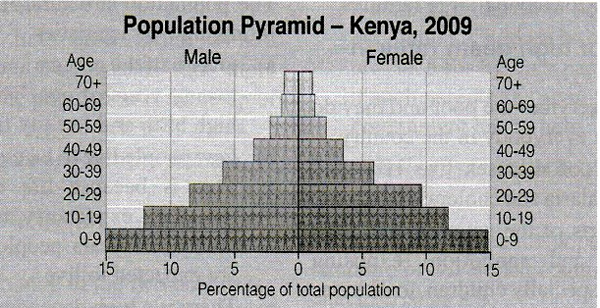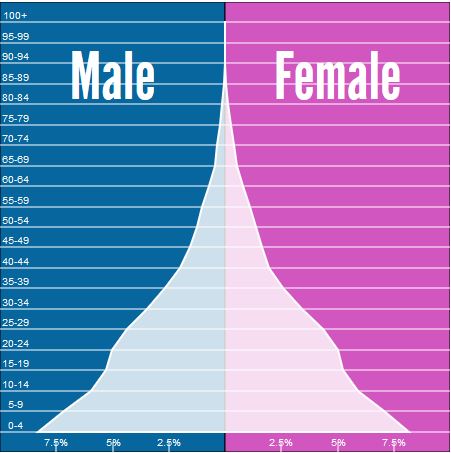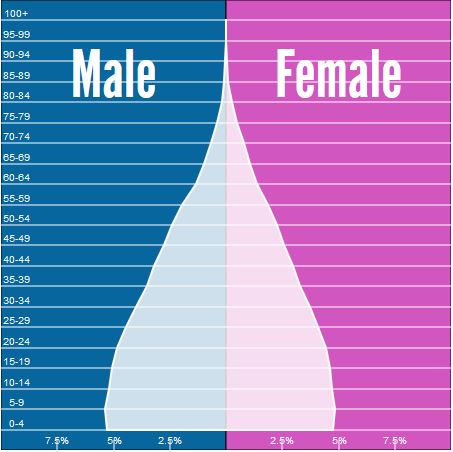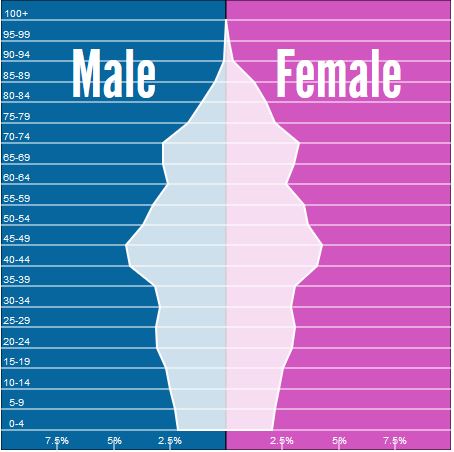Population structure
This is the number of females in each age group compared to males.
This information is usually presented in form of a pyramid.
Factors influencing the population structure
Population structure of any country is influenced by the following factors;
a) Birth rate: This is the number of children born in a country per 1 000 people per year.
b) Death rate: This is the number of people that die in a country per 1 000 people per year.
The rate at which people in a country die is called mortality rate.
The rate at which children die before their first birthday is called infant mortality rate.
The rate at which babies die before their fifth birthday is called child mortality rate.
c) Migration: This can greatly change the structure of population.
When people move into a country, population increases.
When they move out, population decreases.
Kenya’s population structure in 2010


Population structure of Kenya
Kenya’s population structure has the following characteristics:
- Many babies are born and people tend to have large families.
- Many people, especially children die.
- Few people live to the age of 65 years or more.
- More than half the population is aged below 15 years.
- The number of males and females in the population is about the same.
- The majority of people in Kenya are dependants. They are either below 15 years old or over 65 years old. They depend on other people or government to take care of them.
Reasons for high birth-rates in Kenya
- Family planning services are not readily available in all parts of the country.
- People in Kenya want to have many children so that they can support them when they grow old.
- Children in some communities work on farms and in homes. This makes families want to have many children.
- Some couples prefer to have girls or boys. As a result they have many children as they look for a particular sex. They have not realised that children are valuable whether they are girls or boys.
- Some religions do not allow their followers to use family planning methods.
- Since infant mortality is high, families tend to have many children with the hope that some of them will survive.
- Teenage pregnancies increase birth rates.
- Some girls get married at a young age, making them to give birth to many children.
- In areas where girls do not go to school, they do not fully understand the need to plan their families.
- In some communities people are respected for having large families.
Reasons why death rates in Kenya are high
- Medical services are poor and they do not reach everybody in the country.
- Outbreak of diseases like HIV and AIDS, Malaria and cholera is common.
- Many parts of the country have poor hygiene and sanitation, exposing people, especially children to diseases like diarrhoea and dysentery.
- Lack of clean drinking water causes water borne diseases especially in rural areas.
- Poor nutrition.
- Many people, especially the poor, lack balanced diet which causes them to suffer from malnutrition.
Population structure of India
The population structure of India is similar to that of Kenya. This is because both countries are less economically developed.
- Over half the population is aged below twenty years of age.
- Few people live to be sixty years old. This is because life expectancy is low. Life expectancy is the average number of years people in a country expect to live.
- Because of this structure, few people earn a living and pay taxes. Many have to be provided for by the government because they are dependants.
- As a result, the government has to spend a lot of money to provide services like education, health, roads and water.
Population structure of India in 2010


Video on population pyramids
[resource: 5087, align: left]
[resource: 5087, align: left]
Comparison between population structure of Kenya and India
India is one of the countries with the highest population in the world.
According to an estimate done in 2004, its population now stands at about 1 000 million (1 billion) compared to Kenya’s which stands at about 38 million.
The similarities in population structure are discussed below;
- They are both broad-based with a narrow top. This means that more than half the population is made up of young people aged below 15 years.
- The birth rate is high.
- Death rate in the two countries is high.
- Life expectancy in the two countries is low, and as a result, very few people live to become 65 years old.
- In both countries, there are about the same number of males and females.
Problems associated with population structures of Kenya and India
- Young people are dependants and need to be taken care of and provided for. This menas that a lot of services need to be provided and paid for.
- A young population means that the population will grow very fast in the future.
- Such a population has fewer people working and fewer people pay taxes.
- The government spends more money planning for the basic needs of the population. Children have to be provided for by their parents, and if such parents are poor, then the government has to help.
Population structure of Germany
- Birth rate is low because many people use family planning services
- Death rate is also low.
- Life expectancy is high.
- The structure is balanced.
- There are about the same number of young people as mature people.
- There is an ageing population because the young people in the population are few.
Population structure of Germany in 2010







